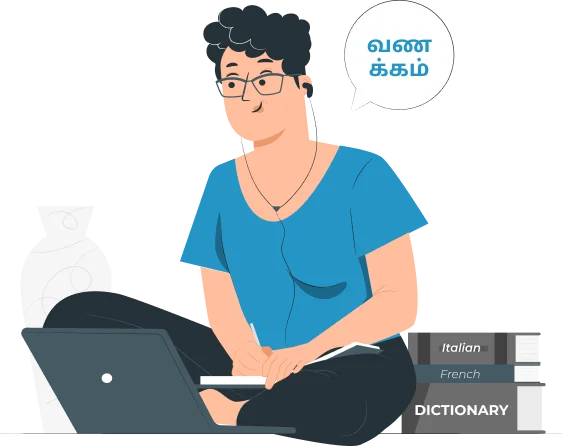
Go Global with Professional Tamil Translations
Tamil is the official language of Sri Lanka (3.1 million), Malaysia (2 million), and the Indian State of Tamil Nadu (70 million). It is one of the oldest South Asian languages dating to more than 2500 years. The International Tamil-speaking population accumulates to almost 84 million people.
Interestingly, the Tamil language is not limited to its borders, Tamil language speakers are also present in many European and Western countries. Among the many dialects and accents of the Tamil language, the “Central Tamil dialect” is the most prevalent. So, if your business or brand is looking to go beyond the local markets, CCJK’s professional Tamil translation services will give you an ideal jumpstart over your competitors.
Industry Leading Tamil Translation Services
When it comes to exceptional Tamil translation services, CCJK stands unrivaled. Our extensive network boasts over 30,000 certified linguists dedicated to delivering the highest-quality Tamil translations, consistently meeting deadlines and budgetary requirements.
As the leading Tamil translation company with fully ISO and ATA-certified status, CCJK guarantees that every Tamil translation project adheres to the most rigorous standards of quality and accuracy. Moreover, the same is the case if you are looking to target Tamil markets and need English to Tamil translations. This is exactly where you need CCJK’s professional English to Tamil translation services on your side.

We translate all kinds of Tamil documents
Need to translate Tamil documents? You’re in the right place. As a leading translation service provider, CCJK understands and fulfills the responsibilities of leading Tamil language translation services.
Technical translations into Tamil
Tamil medical translation services
Website translation into Tamil
Tamil legal translations
Technical translations into Tamil
In the diverse spectrum of the globalization process, translation plays a vital role. Moreover, technical translation aligns with literal translations. Furthermore, translating technical ideas, user guides, terms, and conditions, etc. requires industry-expert language professionals. Major companies, businesses, and brands acquire industry-leading Tamil translation services to carry out this crucial task of cross-linguistic and cross-cultural translations. Whether you need English to Tamil or Tamil to English translation services, CCJK is always ready to assist you with your project of any size.
Tamil medical translation services
CCJK’s dedicated team boasts hundreds of certified Tamil linguists specializing in scientific and medical fields. We cater to a diverse range of life science entities encompassing pharmaceuticals, biotechnology, medical devices, IVD, CROs, IVR companies, and healthcare marketers. Our certified Tamil translators bring extensive experience in handling various documents, including Tamil clinical trial questionnaires, informed consents, package inserts and labels, and much more. As an industry-leading Tamil translation company, CCJK is always proud to help facilitate this information exchange process by providing accurate medical Tamil translation services.
Website translation into Tamil
Websites are the most important facade of all businesses and brands. There is no room for any error especially when it comes to the translations for localization and globalization. Moreover, translation is the ultimate component of the localization process. It becomes more crucial when there is a complex language like Tamil. Here at CCJK, we always deliver the best Tamil language translation services. We not only translate and localize your website but also adhere to the specific Tamil dialects of your requirements. Contact us today for top-notch Tamil translations.
Tamil legal translations
With an impressive support of 800 language pairs, 230 languages, and 40+ industry support, CJK is a well-versed legal translation agency. Our legal language experts are also subject matter experts in the legal domain. Our satisfied client base includes individuals, law firms, financial companies, brands, and retailers in many sectors. These clients trust our modern Tamil translation services in law regulations, intellectual property, tax, insurance, immigration, technology, and more.
Start Your Tamil Translation Now.
Meet our native Tamil translators
In our network of 30,000+ language experts, we’ve many native-speaking Tamil translators who know the language inside out. They know how Tamil is used in different parts of the world and are fluent in all dialects. When you want to hire our Tamil translation services, we’ll connect you with professionals who translate your documents by focusing on a specific dialect according to your target market.
Language support
Tamil translation services in 230 languages
A top provider of Tamil translation services, CCJK allows you to choose between 230 language options to get your documents translated into Tamil or from Tamil to other languages.
